|
Virtual Buildings - Knowledge Representations and Semantic Web
IT i Civilingeniørspeciale i Byggeledelse/IT in Building Management. 2006
1. Background
[goto top]
Since the introduction of the world wide web (WWW) and standardisation of Internet services and communication protocols we can see a huge shift in the way we communicate, collaborate and handle digital knowledge. The semester 7 course focuses on models and representations of building products and processes. (In the semester 8 course we take an end user perspective on how ICT tools can support collaboration, communication and access to Internet based computer resources.)
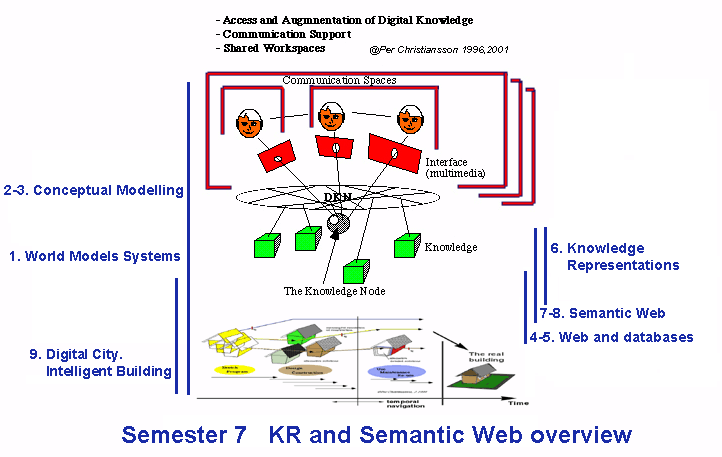
The anticipated ICT tools are only partly developed and must be designed tested and implemented in close collaboration with the building process end users. This requires that civil engineers get a deeper understanding of some knowledge domains that up till now only has been partly covered in the civil engineering curricula.
The ICT will strongly influence how we take advantage of and interact with the computer resources
- information storage and interaction media will be more separated (paper is both)
- it will be easier to adapt information containers to user needs and usage context (meta data, models interoperability, model access, etc.)
- buildings and building processes will be more effectively and efficiently represented in digital models with different knowledge representations.
- the web will form the infrastructure for information container access, and application communication
- human collaboration, team work and communication modes will be developed and partly changed
- collaboration work spaces will get a added virtual dimension being less dependent of the physical room.
The mutual influence between practice and ICT progress is necessary to maintain. Civil engineers must posses both general and some specialised ICT related knowledge to be able to specify and participate in the development of new ICT tools and to be pro-active in the process of changing work routines and company and project organisation.
This course aims at providing general knowledge on how
present and future digital product and process models can be designed and implemented as well as deeper knowledge in certain key areas such as conceptual modelling methods, different knowledge representation propereties, web-database integration, the semantic web, and model integration.
See also Building Inofrmatics Overview
and Steinman, 2004, The Job Profile of Construction Informatics
2. Goal
[goto top]
The goal of the Building informatics course in 'Knowledge Representations and Semantic Web' is to mediate knowledge
about fundamental concepts, technologies and methods to analyse and develop
models which describes a building, the building process and the digital
infrastructures from design to application as well as mediation of knowledge about how the future services, systems, and infrastructures for knowledge management can be built and integrated.
3. Volume/Placement
[goto top]
This 2 modules course is one of 2 with emphasis on IT during the semester 7 Master of IT in Building Management education
(calendar).
4. Content
[goto top]
Explaining Knowledge Management.
Knowledge Management tools. Principles for meta-structuring in web based
structures. Project webs. Properties of the next generation Semantic
Web. (XML, RDF).
Knowledge
representations in practice.
Web database integration.
Existing classification systems and meta classification methodologies.
Conceptual and data modelling techniques.
(Acquisition and storage of building process data. Design and development
of services for knowledge transfer and knowledge management.)
Introduction to conceptual modelling methods and languages.
Building Product Models in perspective.
(Cad system properties.)
(Building applications supported by product models.)
(Future structures of virtual building models.)
(International Foundation Classes, IFC.)
IT infra structures and intelligent buildings
5. Learning Material
[goto top]
The course content is delivered through the lectures, reading of literatur , and exercises/miniproject. It is impossible to find a set of literature that covers the course content completely. The lectures are supported by lecture slides available on the course web site. The slides with emphasized titles in the navigation bar has the same status as course literature (though not eventual references on the slide).
References to further reading is found in the lecture notes.
The coarse literature consists of both Lecture Slides and literature according to the list below.
The 'IT in Civil Engineering' site (http://it.civil.auc.dk/) also gives access to
previous years courses and if applicable mini projects. You reach it from the top of this page.
5.1 Lectures
[goto top]
The lectures are accessed from the lecture scheme below.
Each lecture has a easy to navigate slide bar and an opening slide with
short content description, questions for self assessment, references to the literature according to the literure list below and proposals for further reading.
The four hour lecture/exercise followes the scheme
- 1 hour lecture
- 1 hour exercise in group
- 2 hours exercise results presentation and follow discussions
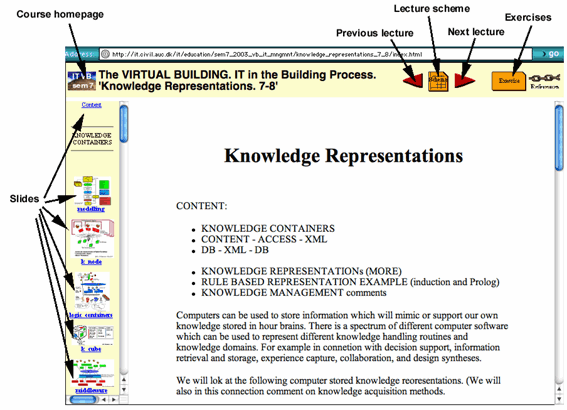
5.2 Exercises/Mini-project
[goto top]
The exercies are also accessed from the lecture scheme below. Student group exercises results are continously updated
The exercices may well take use cases from the ongoing semester project or even be contained in a mini-project defined by the group.
The following domains will be covered during the exercices
- Write scenario(s) of the future ICT supported building process
- Conceptual modelling of your semester 7 project
- Database design and web access
- Knowledge representations
- Meta structuring of information using XML and RDF
- New services in digital cities and intelligent buildings
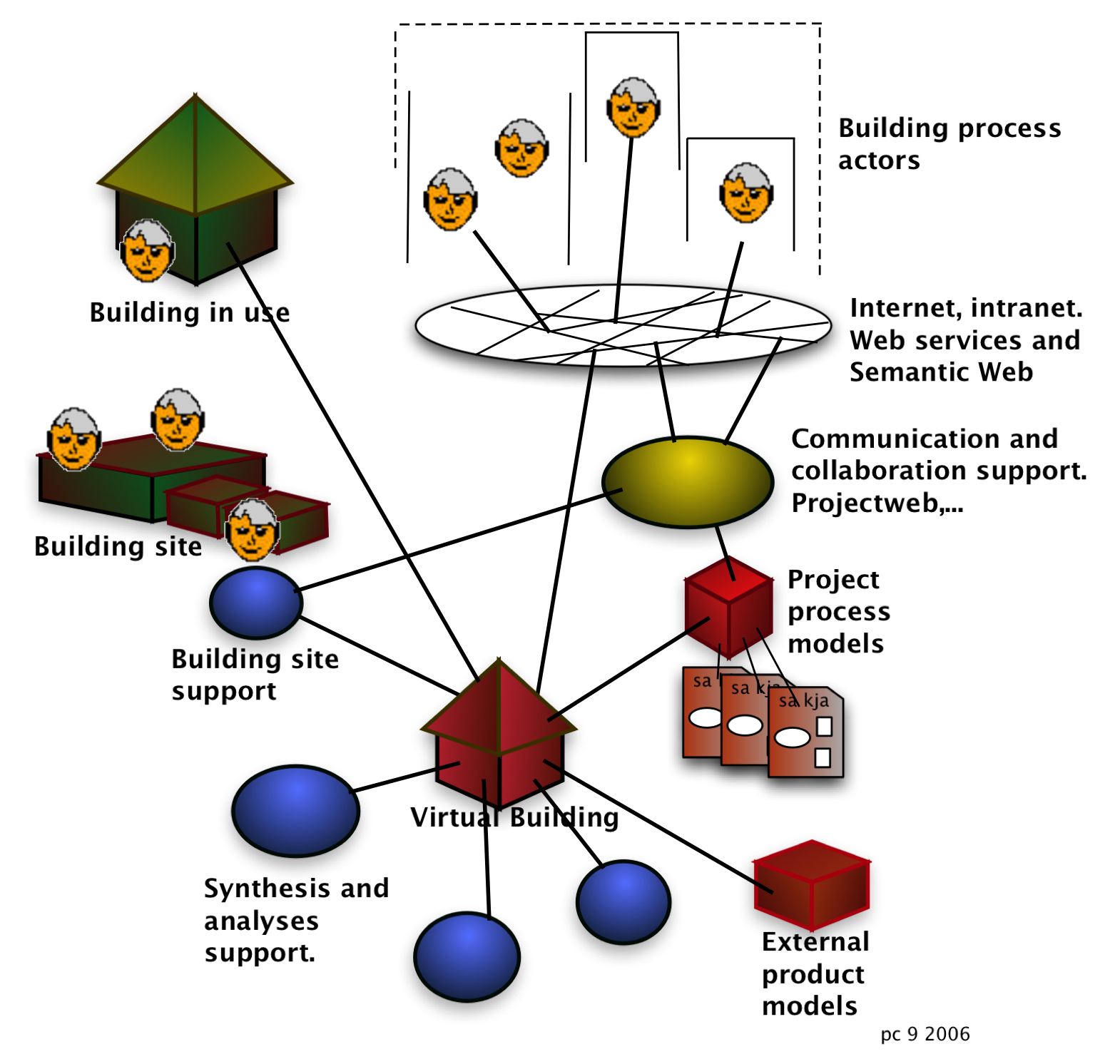
The course exercises uses modelling domains of this figure.
5.3 Software
[goto top]
The following ICT, Information and Communication tools, are available during exercises/minproject activity. (those marked with * only at the Media Lab at institute 6)
5.4 Literature
[goto top]
|
/1/
|
Christiansson P, Carlsen M (2005) Virtual Building from Theory to Practice.
Proceedings W78 22nd Conference on Information Technology in Construction. Edited by R.J. Scherer,
P. Katranuschkov, S.-E. Schapke. Dresden July 19-21, 2005. (pp. 171- 175).
|
|
/2/
|
Rasmussen Annelise, 1996, "Introduktion til IDEF0 Version 1.1". Institut for Anvendt Konstruktion og Produktion. Danmarks Tekniske Universitet. Lyngby (30 pages)
|
|
/3/
|
Miller R, 2003, "Practical UML: A Hands-On Introduction for Developers". Borland Developer Network. (7 pages).http://bdn.borland.com/article/0,1410,31863,00.html. [local].
|
|
/4/
|
Frederiksen Helle, 2000, "Databasedesign med Access 2000". IDG Forlag, Valby. (103 pp.). http://www.idgforlag.dk/. ('Centrale databasebegreber sid. 6-11, 'Normalisering'
sid. 60-63). ('Analyse' sid. 36-38, 'Dataanalyse'
sid. 51-56). ('SQL-forespørgsler'' sid. 24-28).
education/reports/access2000.pdf
|
|
/5/
|
Christiansson P, Herrera A, 1987, "Kunskapsbaserade system/expertsystem. Värdering av några existerande verktyg" / "Knowledge Based Systems/Expert systems.
Evaluation of some existing tools". NBS-DATA seminarium, Oslo, 24-25 september 1987. (15 pp).
|
|
/6/
|
Johnson, M., 1999, "XML for the absolute beginner".
http://www.javaworld.com/javaworld/jw-04-1999/jw-04-xml.html
|
|
/7/
|
Falk V, "LON i dagens Danmark". Dansk Automationsselskab.
|
|
/8/
|
Christiansson P, 2000, "Knowledge Representations and information Flow in the Intelligent Building". 'Proceedings of he Eighth International Conference on Computing in
Civil and Building Engineering. ICCCBE-VIII 2000 (eds: Fruchter R, Pena-Mora F, Roddis K)', ISBN 0-7844-0513-1. American Society of Civil Engineers, Reston, Virginia, USA. (Stanford University, USA. August 14-17, 2000). (pp. 604-611).
KEYWORDS: intelligent building, services, digital city, design, communication
|
6. Examination
[goto top]
Oral individual test based on 1-3 hour discussions a group on a mini project or exercises collection. Assessed with the grade "passed" or "failed" with internal
censor participation.
Examination will take place at 09.00 group 3.108 and 10.00 group 3.110, room 1.201, Friday January 12,
2007. Examinator is Per Christiansson and censor Kjeld Svidt.
Registration no later than January x 2007, 12.00.
The group exercises/miniproject reports and presentation at examination are if available presented here
7. Course Participants
[goto top]
7.1 Students
3.108
Helle Bobach
Morten Brandhøj Olesen
Joans Solhøj Thomassen
Finn Brødbæk Jensen
|
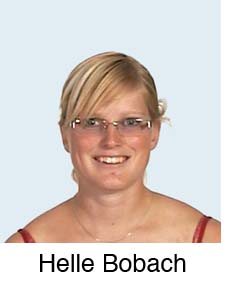
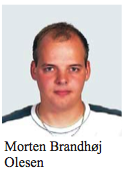

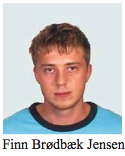
|
3.110
Søren Hermansen
Kasper Kirk
Allan Filskov Jørgensen
Daniel Kristian Hansen
|


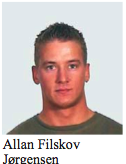
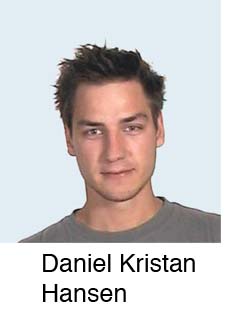
|
Gruppe: 3.108
Projekt: Karl Molin
Produktionsstyringssystem
|

|
Gruppe: 3.110
Projekt: Spæncom
Produktionsstyringssystem
|

|
7.2 Teachers
Prof Per Christiansson (course responsible).
8. Lecture Scheme
[goto top]
1
Tuesday September 19, 2006
12.30-16.15
Fibigerstræde 16,
room 1.111
Aalborg University
(Per Christiansson)
|
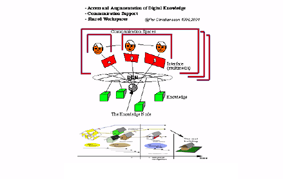
|
WORLD-MODELS-SYSTEMS
This lecture explains and comments the
introduction of IT in the building process during the
latest decades.
But first we look at the fundamental relation between a part of the world, the formalised systems it contains and how these can be modelled and formalised.
Digital models, standards and systems have been developed to support
for example engineering
calculations, stability analyses, simulations, graphic
presentations, time planing, resource management,
and documentation.
Building product and process models are explained and exemplified as well as
relevant knowledge management issues including new ways to handle information containers in local to global networks.
|
|
Literature
/1/
Exercise A
|
2-3
Tuesday September 26, 2006
12.30-16.15
Fibigerstræde 16,
room 1.111
Aalborg University
(Per Christiansson)]
Tuesday October 3, 2006
12.30-16.15
Fibigerstræde 16,
room 1.101
Aalborg University
(Per Christiansson)
|
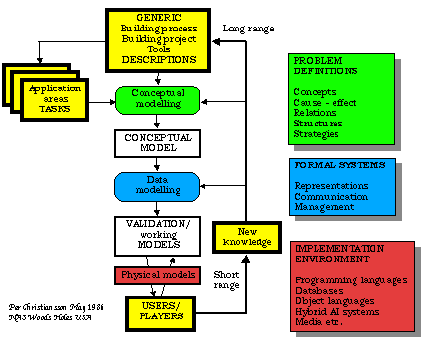
|
Conceptual Modelling
Before we arrive to the actual implementation of our data
models in computer systems we must make so called
conceptual models.
A conceptual model is a high level description of parts of and the
whole process we are considering for computer application.
It will help us to understand and describe the world we
are dealing with (even if we do not intend to make a
computer implementation). There are different conceptual modelling
methods which are suited for different or similar
application areas.
We will look at conceptual modelling of the building product and
it's time dependent properties (process models) during
specification, design, contruction, use,
and demolition/recycling of the building product. Special focus will be on the UML (Unified Modeling Language).
We will also mention the so called Contectual Design method
for capture of user requirements and user enviroenment design in connection
with system development and relate it to UML.
|
|
Literature
/2/,/3/
Exercise B
|
|
4-5
Tuesday October 10, 2006.
Fibigerstræde 16,
room 1.111
Aalborg University.
12.30-16.15
(Mads Carlsen)
Wednesday October 11, 2006.
Fibigerstræde 16,
room Fib14:59
Aalborg University.
08.15 - 12.00
(Per Christiansson)
|
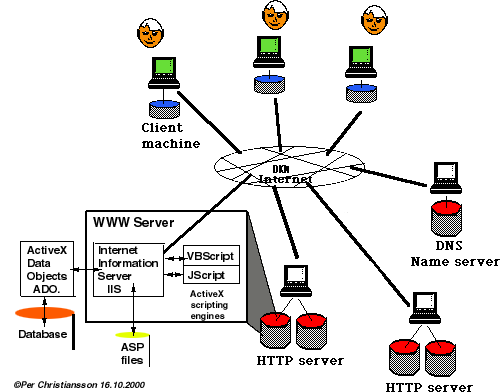
|
WEB AND DATABASES
Relational databases is and will be an very important information container
for building process and product information.
We will repeat some database basics from semester 6 (normalisation, SQL calls
to databases).
We will also learn about the principles and methods behind connecting databases to web browsers.
You will make a small database (part of a company project web) and explain how it can be made accessible from the web.
We will try out and analyse some existing project webs (Byggeweb) used in construction projects and in connection with R&D projects involving industry collaboration. You will reflect on needs and requirements specification as well as how this technology, models, and information containers [project webs] could be used in building projects, to support company costumer relations and company knowledge management.
|
|
Literature
/4/
Exercise C
|
|
6
Monday October 23, 2006.
Fibigerstræde 16,
room 1.211
08.15-12.00
(Per Christiansson)
|
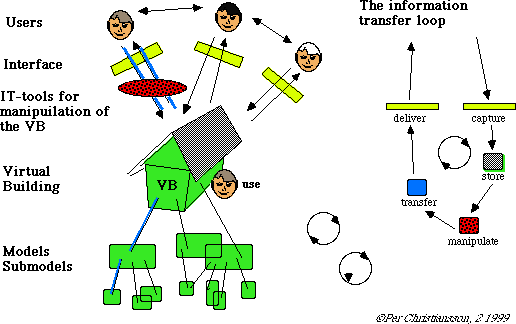
|
KNOWLEDGE REPRESENTATIONS
We will look at different ways to transfer conceptual models to more structured data models that can be implemented and accessed through different knowledge representations implemented in digital computer systems.
|
|
Literature
/5/
Exercise D
|
7-8
Tuesday October 25, 2006
08.15-12.00
Fibigerstræde 16,
room 1.211
Aalborg University
Wednesday November 1, 2006
08.15-12.00
Fibigerstræde 16,
room 1.211
Aalborg University
(Mads Carlsen)
(Per Christiansson)
|
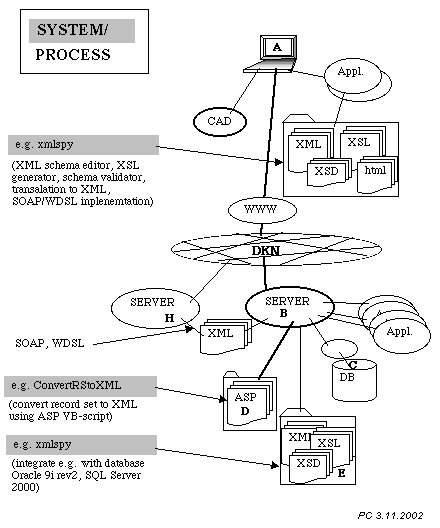
|
THE SEMANTIC WEB
Computers can be used to store information which
will mimic or support our own knowledge stored
in hour brains. There is a spectrum of different
computer software which can be used
to represent different knowledge handling routines
and knowledge domains. For example in connection with
decision support, information retrieval and storage,
experience capture, collaboration, and design syntheses.
We focus in this course on relational databases (see 5-6. Web and Databases) and hypertext representations supported by HTML (with recap of
HTML basics) and the new ways can separate content and access of
web based hypertext information (XML, XSL, XSD).
You will also get a short insight into other representation forms such as
production
systems, predicate logig based systems, artificial neural networks, induction systems, and analogue
representations (Object representations are covered in another
course and will only be touched upon here).
We will during lecture 8 dive deeper into the
principles for meta-structuring of web based information
containers (URIs) in web based environments using
Semantic Web technologies.
|
|
Literature
/6/,
Exercise E
|
9
New Time
Tuesday November 28, 2006
12.30-16.15
Fibigerstræde 16,
room 1.211
Aalborg University
(Per Christiansson)
|
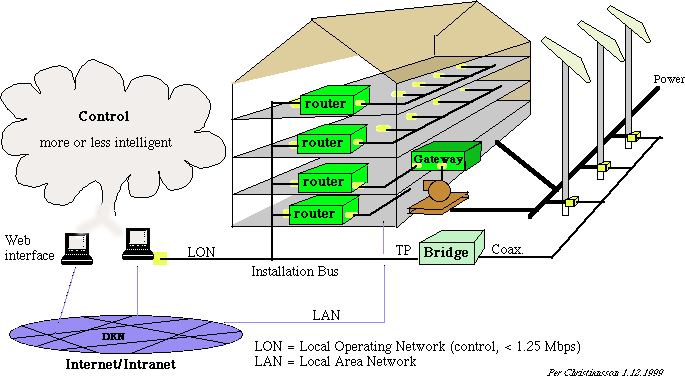
|
9. THE DIGITAL CITY AND SOCIETY.
THE INTELLIGENT BUILDING
Information technology,IT, will cause a paradigm shift in
our society from the art of writing, printing to the art
of communication.
In the same way as the car highly influenced the physical
design of our society IT will higly influence the forming
of the global villages.
New services will be designed and implemented in the
citizen nets to support
the village inhabitants - access to services and
facts bases, and possibilities for active participation in
the (democratic) decision process.
We will study and analyse ongoing efforts in the area.
The building product itself will contain or have attached
to it IT-tools which will support it during it's life
time. Information handling and communication support
will be given for the building inhabitants,
for the adminstration of the building and it's operation and maintenence
(O&M). The IT support will be in the form of conventional computer systems and sophisticated input/output units as well as in the building
and installations embedded computer systems.
We will investigate exisiting and expected infrastructures,
systems, and services in the intelligent buildings and digital cities,
and how they can be designed, modelled, and implemented.
|
|
Literature
/7/, /8/
Exercise F
|
10
Tuesday January 12, 2007
08.15 -12.00
Fibigerstræde 16,
Room 1.208
Aalborg University
(Per Christiansson)
|
|
Literature
/xx/, /xx/
|
[goto top]
|
|




